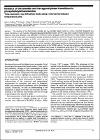| dc.contributor.author | CAFFREY, MARTIN | en |
| dc.date.accessioned | 2011-02-11T18:54:08Z | |
| dc.date.available | 2011-02-11T18:54:08Z | |
| dc.date.issued | 1990 | en |
| dc.date.submitted | 1990 | en |
| dc.identifier.citation | Caffrey M, Magin RL, Hummel B, Zhang J, Kinetics of the lamellar and hexagonal phase transitions in phosphatidylethanolamine. Time-resolved x-ray diffraction study using a microwave-induced temperature jump., Biophysical journal, 58, 1, 1990, 21-9 | en |
| dc.identifier.issn | 0006-3495 | en |
| dc.identifier.other | Y | en |
| dc.identifier.uri | http://hdl.handle.net/2262/50467 | |
| dc.description | PUBLISHED | en |
| dc.description.abstract | The kinetics of the thermotropic lamellar gel (L)/lamellar liquid crystal (La) and La/inverted hexagonal (H,,)
phase transitions in fully hydrated dihexadecylphosphatidylethanolamine (DHPE) have been studied. Measurements were
made by using time-resolved x-ray diffraction (TRXRD) to monitor progress of the transitions. In these studies microwave
energy Ot 2.5 GHz was used to increase the sample temperature rapidly and uniformly through the phase transition regions.
The L.,/La, and La/Hi1 transitions of DHPE were examined under active microwave heating and passive cooling. The
transitions were found to be repeatable and reversible, and to have an upper bound on the time required to complete the
transition of <3 s. Regardless of the direction of the transition, both phase transitions appeared to be two-state with no
accumulation of intermediates to within the sensitivity limits of the TRXRD method. The rate and amplitude of the temperature
jump can be controlled by regulating microwave radiation input power. A temperature jump rate of 290C/s was obtained at a
final microwave power setting of 120 W. Comparisons between previously reported fluid flow (Caffrey, M. 1985.
Biochemistry. 24:4826-4844) and microwave heating studies suggest that the determination of limiting transit times will
require faster heating. | en |
| dc.description.sponsorship | We thank B. W. Batterman (National Science Foundation, Grant DMR
81-12822) and the entire CHESS and MacCHESS (National Institutes
of Health, Grant RR-014646) staff for their invaluable help and
support. The assistance of A. P. Mencke with image processing and data
reduction and interpretation is gratefully acknowledged. We also wish to
thank E. C. Burdette of Labthermics Technologies, Inc., Champaign,
IL, for assistance in the temperature measurements and for the loan of
the Luxtron model 2000 fluoroptic thermometer that was used in these
experiments.
This work was supported by a grant from the National Institutes of
Health (DK 36849) and a University Exploratory Research Program
award (The Procter and Gamble Co.) and a Du Pont Young Faculty
Award to M. Caffrey. | en |
| dc.format.extent | 21-9 | en |
| dc.language.iso | en | en |
| dc.relation.ispartofseries | Biophysical journal | en |
| dc.relation.ispartofseries | 58 | en |
| dc.relation.ispartofseries | 1 | en |
| dc.rights | Y | en |
| dc.subject | Atomic, molecular and chemical physics | en |
| dc.subject | x-ray diffraction | en |
| dc.title | Kinetics of the lamellar and hexagonal phase transitions in phosphatidylethanolamine. Time-resolved x-ray diffraction study using a microwave-induced temperature jump. | en |
| dc.type | Journal Article | en |
| dc.type.supercollection | scholarly_publications | en |
| dc.type.supercollection | refereed_publications | en |
| dc.identifier.peoplefinderurl | http://people.tcd.ie/mcaffre | en |
| dc.identifier.rssinternalid | 70843 | en |
| dc.identifier.doi | http://dx.doi.org/10.1016/S0006-3495(90)82350-X | en |
| dc.identifier.rssuri | http://dx.doi.org/10.1016/S0006-3495(90)82350-X | en |




